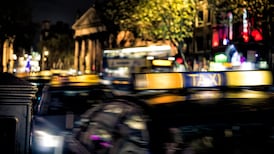Ireland’s wet Atlantic weather and hilly coastline might make it seem like a poor choice to spend weeks on end cycling and camping.
But for Bríd McGovern and Bruce Doolan, recently retired and living in Dublin, the chance to feel “the fresh air” and enjoy “the scenery as you go along” is unmatched.
The couple, aged in their 60s, have been on three cycling holidays in Ireland in the past year, tackling the EuroVelo route that runs from Belfast across Northern Ireland, down the west coast and along the south coast to Rosslare, Co Wexford.
While appearing similar to the Wild Atlantic Way, the EuroVelo, managed by Doug Corrie of Cycling Ireland, does everything to keep cyclists off busy main roads. About 7 per cent of the route consists of greenways in counties Waterford and Mayo.
RM Block
Doolan explains how following the blue, starred signs of the EuroVelo “brought [them] around bockety roads with grass in the middle of them ... which is something you wouldn’t have seen if you were on the main road”.
“We didn’t have to battle the traffic, which was wonderful,” says McGovern. “We could see things and smell the smells and hear birds singing and not be worrying about cars on the road ... it was like finding a bit of gold.”
The EuroVelo is a network of 17 cycling routes all over Europe co-ordinated by the European Cycling Federation, two of which pass through Ireland.
The Atlantic route begins at the northernmost point in Europe and follows the Norwegian fiords and Scottish glens across to Belfast. The Irish element is divided into 40 sections that are each doable in a day, ending at Rosslare Harbour. From there, it continues through England, France, Portugal and Spain.
The second route, the ‘Capitals route’, is still under development and connects the big European capitals, starting in Galway and travelling eastward through Dublin, London, Amsterdam, Berlin and Warsaw.
[ How cycling has economic as well as health benefitsOpens in new window ]
The routes are “quite big in Europe, but even in Europe it’s not that well known”, says Corrie, who says managing the EuroVelo in Ireland is his “passion”.
While working for Sport Ireland, he spent five years roadtripping around Ireland trying to persuade local authorities to signpost the route and government departments to fund it. In May 2023, he was finally able to launch it and cycled the route in its entirety that summer.

Cyclists say Corrie is very helpful, always on hand to offer mapping tips or point them in the right direction of gear, facilities and scenic spots.
Christy Keeler (57), an endurance sport enthusiast from Las Vegas in the US, says Doug “was amazing and he was there for me. He would sit down with the map and do little changes to make it easier for me”.
Over 40 days in March and April of this year, Keeler travelled 2,411km by bike and foot, exploring the length and breadth of the island.
The trip was not without its challenges. Keeler had planned to camp to save money, but found the dampness, lack of official camping grounds and weight on her bicycle made it too difficult.
She ultimately booked into hotels and hostels and rented Airbnbs, which meant ditching her tent and adding €2,500 to the cost of her trip.
The steepness of the coastal roads was another challenge while travelling on her road bike.

“I am 5ft 2in, 155lb, and turned 57 when I was there,” Keeler says. “It’s not like I’m a Tour de France rider, so I got to the point that after the first 10 days, I was going to have to take the [national] roads because the [local and regional] roads were too hard and it would take me too long to get to the next place.”
Similarly, Eamon Kelly (58), who is living in Belfast, is using the EuroVelo to explore the island.
“I lived in Ireland until I was 18 or 19 and then, like a lot of people of my generation, left to work around the world,” he says. “We’re just coming back. So I really haven’t spent much time in Ireland and I would like to explore it a little bit. That was more my motivation.
“I prefer cycling to travel, rather than cycling as a club cyclist or cycling long distance. It’s more slow travel for me rather than a sport.”

Kelly also admires the fact that the routes stretch across countries. “You could spend your life doing EuroVelos.”
Even though many cyclists like Kelly do parts of the route by themselves, he says, “When I see people with panniers and they see me with panniers I think there’s inevitably a stop and ‘Where are you going and coming from? What’s the route?’…. You kind of compare stuff, so I think that’s very friendly.”
He says he is “really enjoying seeing all these lovely small towns and villages that it brings you to. It’s just a great experience”.
None of the cyclists are puritanical about staying exactly on the route, but will often take a detour to visit a castle, see some cliffs, have a shower in a hotel or eat in a good cafe.
“On the bike, you have such an appetite for really nice food and the coffee and the cakes taste so much better – and we feel we’ve earned them as well,” says McGovern.
Some cyclists mention the lack of cheap accommodation in the form of hostels and campsites along the way as one downside to this form of travel, particularly outside of the summer season.
Then again, “nothing in Ireland is cheap” says McGovern, sighing.
The way the route is sectioned means that unless you’re like Kelly and try to do multiple sections in one day, you arrive home feeling invigorated rather than exhausted.
“[T]here’s a certain sense of adventure and ... a sense that we’ve achieved something”, says McGovern.












